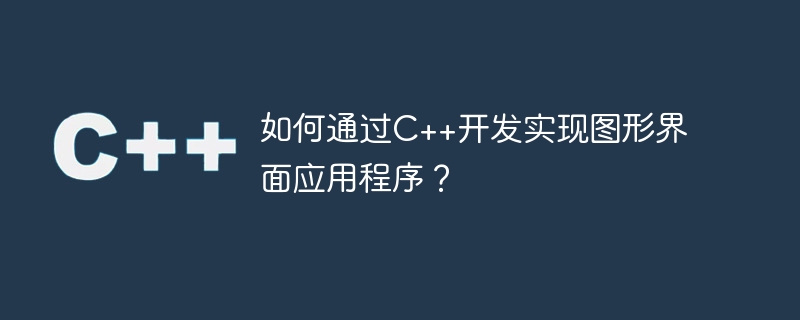Home >Backend Development >C++ >How to implement graphical interface applications through C++ development?
How to implement graphical interface applications through C++ development?
- WBOYWBOYWBOYWBOYWBOYWBOYWBOYWBOYWBOYWBOYWBOYWBOYWBOriginal
- 2023-08-25 23:42:215682browse

How to develop and implement graphical interface applications through C?
Introduction:
Graphical interface application is a kind of software that is often used in our daily life. It can provide an intuitive and friendly interface, allowing users to use computers more conveniently. C is a powerful programming language that can also be used to develop graphical interface applications. This article will introduce the basic steps of developing graphical interface applications through C, and demonstrate it using a simple calculator application as an example.
Step 1: Select the graphical interface library
When using C to develop graphical interface applications, we need to choose a suitable graphical interface library. Commonly used graphical interface libraries include QT, MFC, wxWidgets, etc. This article will use QT as an example for demonstration, because QT is a cross-platform development framework that supports multiple operating systems.
Step 2: Install QT development environment
Before using QT for development, we need to install the QT development environment. You can download the version that suits you from the QT official website and install it according to the installation wizard.
Step 3: Create QT project
Open the QT development environment, click "File" in the menu bar, select "New Project", select "Qt Widgets Application", click "Next" and fill in the project information and finally click the "Done" button. This creates a new QT project.
Step 4: Design the interface
Use QT’s interface designer to easily design the graphical interface. In the QT development environment, you can select "Design" mode, then drag the control into the window, set the properties and layout of the control, etc. The specific interface design needs to be set according to your own needs.
Step 5: Write code
In the QT project, you can select the "Edit" mode and then open the corresponding header file and source file. Add the required member variables and member functions to the header file, and implement these functions in the source file. The following is a sample code for a simple calculator application:
#include <QtWidgets>
class Calculator : public QWidget
{
Q_OBJECT
public:
Calculator(QWidget *parent = nullptr);
private slots:
void compute();
private:
QLineEdit *m_number1;
QLineEdit *m_number2;
QLabel *m_result;
QPushButton *m_computeButton;
};
Calculator::Calculator(QWidget *parent)
: QWidget(parent)
{
m_number1 = new QLineEdit;
m_number2 = new QLineEdit;
m_result = new QLabel;
m_computeButton = new QPushButton("计算");
connect(m_computeButton, &QPushButton::clicked, this, &Calculator::compute);
QVBoxLayout *layout = new QVBoxLayout;
layout->addWidget(new QLabel("数字1:"));
layout->addWidget(m_number1);
layout->addWidget(new QLabel("数字2:"));
layout->addWidget(m_number2);
layout->addWidget(m_result);
layout->addWidget(m_computeButton);
setLayout(layout);
}
void Calculator::compute()
{
int num1 = m_number1->text().toInt();
int num2 = m_number2->text().toInt();
int result = num1 + num2;
m_result->setText("结果:" + QString::number(result));
}
int main(int argc, char *argv[])
{
QApplication app(argc, argv);
Calculator calculator;
calculator.show();
return app.exec();
}Step 6: Compile and Run
After writing the code, you can click the "Build" button in the menu bar to compile. If the compilation is successful, you can click the "Run" button in the menu bar to run the application. This way you can see the effect of the graphical interface application.
Summary:
Developing graphical interface applications through C can take advantage of the rich C language features and the functions of various graphical interface libraries to achieve an intuitive and friendly interface. In this article, we use QT as an example and provide a code example for a simple calculator application. I hope this article will help you understand how to implement graphical interface applications through C development.
The above is the detailed content of How to implement graphical interface applications through C++ development?. For more information, please follow other related articles on the PHP Chinese website!
Related articles
See more- What is the name of the workbook that is automatically created after starting the excel application?
- What should I do if Office cannot find the license for this application?
- [Hematemesis Summary] 23 VSCode plug-ins to help you improve development efficiency and aesthetics
- What is the memory used to store currently running applications and corresponding data?
- What should I do if the application cannot start normally with error code 0xc000005?

